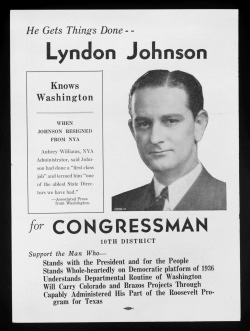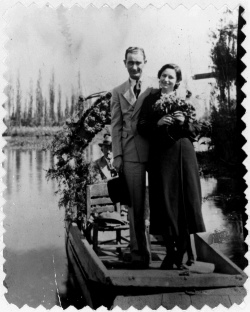Timeline: LBJ and the Nation
1908-1919 1920-1929 1929-1940 1941-1945 1946-1953 1954-1960 1960-1963 1963-1969 1969-1973
1929-1940
The bubble burst on a day history called Black Thursday, October 24, 1929, and the country went into a depression. One out of every four working men was soon out of a job, and capitalism itself appeared imperiled. But for the most part, while the government experimented with social programs to rescue the economy, popular entertainment turned people's attention away from hard times. Radio offered laughter and movies, in what would be seen as their Golden Age, sold romance.
And in every corner of the country, the music that dominated was the big band sound of swing. Even as America fought off the domestic threat to its well-being, dangers much greater were forming farther away as Germany violated the armistice and re-armed. In the Pacific, the Japanese Empire threatened to bring all Asia under its control.
Lady Bird Taylor entered the University of Texas at Austin, where she took two bachelor degrees—in history and journalism. Lyndon Johnson and Lady Bird were married on November 17, 1934, in San Antonio, Texas. At twenty eight, Lyndon Johnson went to Washington as administrative assistant to Texas Representative Richard M. Kleberg, and in 1937, Johnson ran for Congress and won.
Events
- The heady prosperity that had paid the bill for the long party vanished like smoke with the crash of the stock market, symbol and center of the nation's economic life, on a day history called Black Thursday, October 24, 1929. The country went into a depression deeper and more penetrating than any before it. Fortunes were lost overnight and one out of every four working men was out of a job. Bread lines of men out of work presented a grim picture of America in the 1930s.
- Nature added to the bleak portrait when the worst drought in U.S. history descended on the Great Plains. Blistering winds whipped the topsoil from the farmlands that was the nation's "bread basket," turning the vast region into a dust bowl.
- The new president, Franklin Delano Roosevelt, elected in 1932, and his wife, Eleanor, set about to restore hope in the country. His "New Deal" of government programs to lift the nation from depression carried through the 1930s.
Lyndon Baines Johnson
The young Lyndon attended college at Southwest Texas State Teachers College (now Southwest Texas State University) in San Marcos. In 1929 Johnson took a year's leave from college to earn money, accepting a teaching post in Cotulla, in South Texas. The impression made on him by his students, mostly Mexican-American and poor, stayed with him through his lifetime.
Somehow you never forget what poverty and hatred can do when you see its scars on the hopeful face of a young child.... It never even occurred to me in my fondest dreams that I might have the chance to help the sons and daughters of those students and to help people like them all over this country. But now I do have that chance... And I mean to use it.
Lyndon Baines Johnson, March 15, 1965
In August, 1930, Johnson returned to college and graduated. By the fall of that year, he was teaching at Sam Houston High School in Houston. In 1931 he left teaching to become an administrative assistant to the congressman from Texas's Fourteenth District, Richard M. Kleberg.
The energetic and effective young congressional aide came to the attention of President Roosevelt, who appointed him Texas's state director of the National Youth Administration, which put Depression-era youth to work on public projects. When the congressman representing Texas's Tenth Congressional District, James Buchanan, died suddenly in 1937, Johnson threw his hat in the ring. After campaigning as a supporter of Roosevelt, the young congressman-elect celebrated his victory in a hospital bed as he recovered from an appendicitis operation.
As a congressman, Johnson's major interest was the construction of a series of dams to end the devastation of floods, which periodically inundated the Austin area, and to bring electrification to the hill country. He also was instrumental in providing housing to poor constituents.
Lady Bird Johnson
After a year in St. Mary's School for Girls in Dallas, Lady Bird Taylor entered the University of Texas at Austin, where she took two bachelor degrees—in history and journalism. "I suppose the most broadening thing that ever happened to me was entering the University of Texas at age seventeen," she later wrote. "All the doors of the world were suddenly swung open to me. It really was a great learning experience for me as a girl who had led a very narrow life."
She considered becoming either a teacher or reporter in Hawaii or Alaska. "But all that never happened," she later recalled, "Because I met Lyndon." It was a whirlwind courtship and they were married on November 17, 1934, in San Antonio, Texas. Her father, who had encouraged the match, learned about it in a telegram from his new son-in-law. The bride herself announced it in a more unconventional way. "Last night," she wrote a friend, "Lyndon and I committed matrimony."


